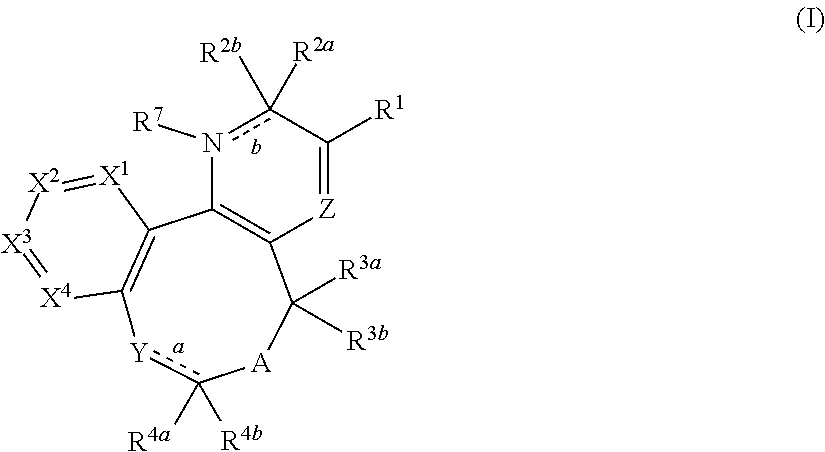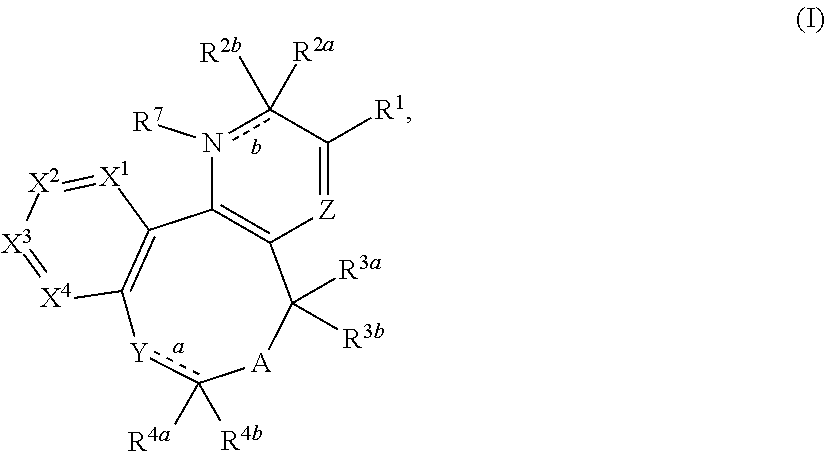Substituted 2-pyridone tricyclic compounds, analogues thereof, and methods using same
a technology of tricyclic compounds and substituted pyridone, which is applied in the field of substituting 2pyridone tricyclic compounds, analogues thereof, can solve the problems of increased risk of liver failure in acute infections, increased risk of liver failure, and more severe complications, so as to reduce or minimize the level of at least on
- Summary
- Abstract
- Description
- Claims
- Application Information
AI Technical Summary
Benefits of technology
Problems solved by technology
Method used
Image
Examples
example 1
yl-9-methoxy-8-(3-methoxypropoxy)-2-oxo-1H,5H,6H-benzo[h]quinoline-3-carboxylic acid
[0353]
(E)-Methyl 3-((3-(benzyloxy)-4-methoxyphenyl)(hydroxy)methyl)-4-methylpent-2-enoate
[0354]
[0355]To Mg metal (2.45 g, 101 mmol) in THF (30 mL) was added iodine (50 mg, 0.2 mmol), and the mixture was heated to 70° C. followed by the dropwise addition of 2-(benzyloxy)-4-bromo-1-methoxybenzene (30 g, 100 mmol) in THF (150 mL). The mixture was stirred for 2 h at 70° C. and then allowed to cool to room temperature and used in the next step.
[0356]To a stirred solution of methyl-3-formyl-4-methylpent-2-enoate (17.5 g, 113 mmol, prepared according to the procedure by Sylvain, et al., 1987, J. Org. Chem. 52:4788) in THF (150 mL) at 0° C. was added dropwise the Grignard reagent prepared in the step above. The mixture was stirred at 0° C. for 1 h. The reaction mixture was quenched with saturated aqueous ammonium chloride solution (100 mL) and extracted with EtOAc (2×100 mL). The combined organic fractions w...
example 2
yl-9-methoxy-8-(3-methoxypropoxy)-2-oxo-1,2,5,6-tetrahydrobenzo[h]quinoline-3-carboxylic-acid-(single enantiomer)
[0371]
example 3
yl-9-methoxy-8-(3-methoxypropoxy)-2-oxo-1,2,5,6-tetrahydrobenzo[h]quinoline-3-carboxylic acid (single enantiomer II)
[0372]
[0373]10 mg of the mixture of enantiomers was separated by SFC (supercritical fluid chromatography) on a CHIRALPACK AD column using 35% IPA (0.4% diethylamine as modifier) to give 5-isopropyl-9-methoxy-8-(3-methoxypropoxy)-2-oxo-1,2,5,6-tetrahydrobenzo[h]quinoline-3-carboxylic acid (single enantiomer I) as a bright yellow solid (faster eluting enantiomer, 1.7 mg, 17%, m / z: 402 [M+H]+ observed), and 5-isopropyl-9-methoxy-8-(3-methoxypropoxy)-2-oxo-1,2,5,6-tetrahydrobenzo[h]quinoline-3-carboxylic acid (single enantiomer II) as a bright yellow solid (slower eluting enantiomer, 2.6 mg, 26%, m / z: 402 [M+H]+ observed).
[0374]Example 2: 5-Isopropyl-9-methoxy-8-(3-methoxypropoxy)-2-oxo-1,2,5,6-tetrahydrobenzo[h]quinoline-3-carboxylic acid (single enantiomer I). m / z: 402 [M+H]+ observed. 1H NMR (400 MHz, CDCl3) δ 13.91 (s, 1H), 12.22 (s, 1H), 8.41 (s, 1H), 7.32 (s, 1H), 6....
PUM
| Property | Measurement | Unit |
|---|---|---|
| w/w | aaaaa | aaaaa |
| droplet size | aaaaa | aaaaa |
| temperature | aaaaa | aaaaa |
Abstract
Description
Claims
Application Information
 Login to View More
Login to View More - R&D
- Intellectual Property
- Life Sciences
- Materials
- Tech Scout
- Unparalleled Data Quality
- Higher Quality Content
- 60% Fewer Hallucinations
Browse by: Latest US Patents, China's latest patents, Technical Efficacy Thesaurus, Application Domain, Technology Topic, Popular Technical Reports.
© 2025 PatSnap. All rights reserved.Legal|Privacy policy|Modern Slavery Act Transparency Statement|Sitemap|About US| Contact US: help@patsnap.com



